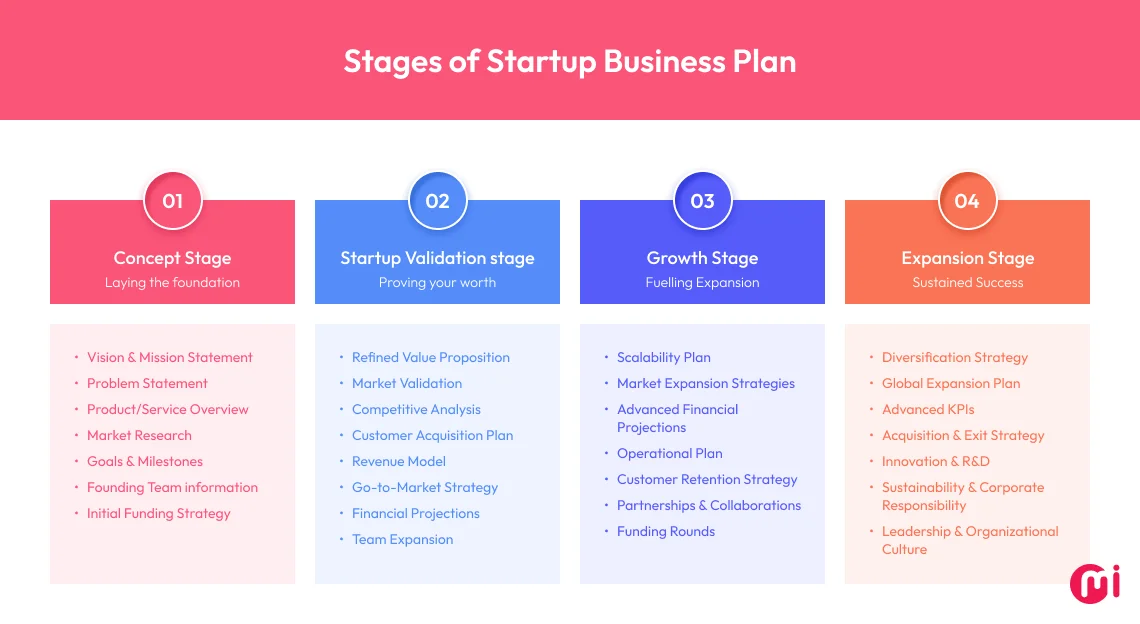Creating a business plan is all about putting a business idea and everything about it (from values to goals and strategies to reach it) in a bird’s eye view. A well-crafted business plan at the initiation stage can set the foundation for a billion-dollar empire, while a poorly designed one can make you miss opportunities. This guide navigates you on what to include in your business plan based on goals and the stage your tech startup is in.
Starting a tech startup with a strong market presence is challenging, but evolving into a billion-dollar company is even more daunting. Did you know that only 1% of startups achieve unicorn status with a valuation of $1 billion?
Among those successful unicorns – Netflix, Airbnb, and Facebook (now META) – got the spotlight! But do you know what sets them apart from their competitors? The common thread is a future-proof business plan that has led them to their current positions.
This essential blueprint not only charts your course but also empowers you to seize opportunities and navigate risks during critical phases of your tech startup journey.
So, whether your tech business is in the concept, validation, growth, or expansion stage, this blog will guide you through how to create a compelling business plan tailored to your unique goals with examples, setting up the foundation for your success.
Planning to create a business plan for your tech-led startup? Our team of BAs and CTO can help you navigate throughout your journey, from product discovery to pitching to investors! Book a free consultation with our team today!
Why Does Your Tech Startup Need A Business Plan?
For improved business operations, strategic expansion, and the ultimate goal of building a brand that attracts customers—leading to better financial growth and sustainability—a well-structured business plan is essential.
A business plan is more than just a formal document; it’s a vital tool that provides a bird’s-eye view, significantly impacting the tech startup’s trajectory.
Whether you refer to those as business benefits, motivation factors, or driving forces, as a tech startup, you should create a business plan to:
Clarify Your Vision
A business plan forces you to articulate your tech startup’s vision, mission, and goals clearly. This clarity not only helps you stay focused but also ensures that your team is aligned and working towards a common objective.
Get Guidance On Strategic Decision-Making
With a comprehensive business plan (covering goals, engagement models/revenue generation strategies, marketing & sales plans, and financial plans), you can make informed decisions backed by research and analysis. It serves as a roadmap that outlines your strategies for growth, funding, and market penetration, allowing you to navigate challenges more effectively.
Attract Investors and Partners
Investors want to see a well-thought-out plan that demonstrates the viability of your business idea. A compelling business plan showcases your understanding of the market, your competitive advantages, and your financial projections, making it easier to secure funding and partnerships.
Identify Risks and Opportunities For Operations
A business plan encourages you to analyze potential risks and opportunities (by learning from mistakes done by competitors) in your landscape through market research and competitor analysis. By assessing these factors, you can develop tech startup contingency plans and strategies to mitigate risks while capitalizing on emerging opportunities and thriving towards your defined goals.
Track Business Performance
Your business plan provides benchmarks against which you can measure your startup’s performance – whether it’s going as you’ve planned or not. By regularly reviewing your progress, you can make adjustments as needed to stay on track towards your goals.
Use It As Your Communication Tool
A well-crafted business plan is an effective communication tool that can help you convey your vision to stakeholders, employees, and potential investors. It serves as a reference point that ensures everyone understands the direction of the company.
In short, in this competitive tech-driven market, having a solid business plan is essential for steering your startup towards long-term success. It lays the groundwork for navigating challenges, seizing opportunities, and ultimately achieving your entrepreneurial aspirations.
Real-World Business Plan Examples from Legendary Startups
Behind every billion-dollar startup lies a well-structured business plan. Companies like Netflix, Airbnb, and Facebook didn’t just succeed by chance – they laid their foundations with future-proof business plans that allowed them to navigate challenges, pivot when necessary, and capitalize on emerging opportunities.
Let’s take a look at how these tech giants used business planning and became legendary startups trusted by billions of users worldwide:
Netflix
Originally launched as a DVD rental service in 1997, Netflix quickly evolved into a leader in streaming media in the internet age, setting the standard for on-demand video platforms. What set Netflix apart was its ability to foresee the future of content consumption. Their business plan wasn’t just about refining existing models—it embraced a forward-thinking approach to digital streaming before it became mainstream.
Let’s take a closer look inside Netflix’s business plan:
| NETFLIX BUSINESS PLAN |
|---|
| OVERVIEW Starting as a DVD rental service, Netflix makes a significant digital shift to meet the demands of adaptability, scalability, and original content creation to reach the revenue increase mark of 300%. |
| PROJECT DEFINITION & SCOPE
Background: Problems being addressed: Alternatives: Limitations: Assumptions: BUSINESS MODEL Subscription-Based Revenue: Pricing Strategy: Affordable and tiered subscription plans to cater to different segments, from basic to premium. International Expansion: Target international markets with localized content offerings. |
| KEY DIFFERENTIATORS – First-Mover Advantage – Adaptability – Content Ownership |
CONTENT STRATEGY – Licensed Content – Data-Driven Content Decisions |
| SCALABILITY – Global Expansion – Robust Streaming Infrastructure – Mobile-friendly |
REVENUE STREAMS – Subscriptions – Partnerships – Marketing Deals |
| MARKETING STRATEGY – Position itself as a leader in innovative, on-demand entertainment. – Build a strong customer base – Promote content heavily through social media |
COMPETITOR ANALYSIS No as such, as making a new market entry with a unique app concept. |
| RISK MANAGEMENT – Reduce reliance on external content – Continue investing in localized and niche content – Keep improving the tech infrastructure to ensure all-time high performance |
“Most entrepreneurial ideas will sound crazy, stupid and uneconomic, and then they’ll turn out to be right” – Reed Hastings Co-founder and Executive Chairman of Netflix
Netflix’s success story is a masterclass in business planning. By identifying business opportunities early in the market, Netflix succeeded in becoming a billion-dollar global entertainment giant. Its business plan continues to evolve, reflecting its ambition to maintain leadership in a highly competitive digital entertainment industry.
So, want to create an online video streaming app like Netflix? Our latest guide on it can help you on that!
Airbnb
Airbnb’s journey from a small startup to a $79.54B company (as of today) is a testament to the power of a strong business plan. The founders envisioned a shared economy that would revolutionize how people travel, offering affordable and unique accommodations.
Initially citing Couchsurfing, Craigslist, Hostels.com, and Hotels.com as competitors, Airbnb went on to surpass major hospitality giants like Hilton, Marriott, and InterContinental Hotels when it made its public market debut.
When the COVID-19 pandemic shut down global travel, Airbnb’s valuation was halved, dropping to $18B during its Series G funding round in April 2020.
At this critical juncture, the company needed a strong business plan to revive its valuation. The revised business plan included:
| AIRBNB BUSINESS PLAN |
|---|
| PROBLEM IT SOLVES – Pricing for customers booking travel online – Hotels can make travelers feel disconnected from the local culture and city There is no easy way to book a stay in a local’s home or become a host to invite travelers to stay with them or on their property |
| SOLUTION AIRBNB BRINGS A web platform where users can rent out their space to host travelers – Save money when traveling – Make money when hosting – Share culture when staying |
| 630,000 On temporary housing site couchsurfing.com |
17,000 Temporary housing listings on SF & NYC Craigslist from 07/09 – 07/16 |
| 1.9B+ Trips Booked Worldwide |
532M Budget & Online Trips |
10.6M Trips AB&B |
| PRODUCT The Airbnb app allows you to book a stay in an easy manner. All users have to do is: SEARCH BY CITY —> REVIEW LISTINGS —> BOOK IT! |
| BUSINESS MODEL Airbnb takes 10% of commission on each booking and transaction done through the platform. |
| 10.6M TRIPS AB&B (Market Share) |
$20 AVG FEE ($70/night @3 nights) |
$200M REVENUE 2008 – 2011 |
| MARKET ADOPTION – Events – Partnerships – Dual Listing (can avail MLS (multiple listing services) solution) |
| KEY DIFFERENTIATORS – 1st to Market – Host Incentive – List Once – Ease of Use – Profiles – Design & Brand |
| FUTURE GROWTH PLANNING – Focus on Sustainability – Long-Term Stays – AI and Personalization |
“Build something 100 people love, not something 1 million people kind of like.” – Brian Chesky Co-founder and CEO of Airbnb
By focusing on an asset-light model, trust-building technology, and unique customer experiences, Airbnb has not only disrupted the traditional hospitality market but also paved the way for the shared economy.
Want to know how much it costs to build an app like Airbnb? Our latest study on Airbnb’s product dynamics and pricing factors covers everything you need to know, from features to cost estimation.


Twenty years ago, the social networking platform – “thefacebook.com” was launched exclusively for Harvard’s campus. Soon, it expanded to other campuses across the U.S.
Initially, the plan was simple: to connect college students, alumni, faculty, and staff through a social network. But the founders of thefacebook.com had a broader vision to expand beyond universities and reach the entire world.
To support this vision, they created an initial business plan that acted as a communication tool, demonstrating the network’s success so far and its plans for the future. This plan highlighted the platform’s potential and helped secure its first funding of $500K from billionaire venture capitalist Peter Thiel in August 2004, just six months after its launch.
So, what is its business plan covered that gave them the growth they needed to expand their services? The below information is all about that:
| FACEBOOK BUSINESS PLAN |
| WHAT IS THEFACEBOOK.COM? thefacebook.com is an expanding online directory that connects students, alumni, faculty, and staff through social networks at colleges and universities on the basis of friendship, courses, and more. |
| USER PROFILE Every Facebook user will have a profile, which includes: – Contact information – Personal information – Course information – Profile picture |
| INTRA-SCHOOL NETWORKING Mediums for each Facebook user to find their school’s social network through mediums like: – Social NET – Course Roasters – Advanced Search Engine |
| EXPANSION HISTORY From the launch date to April 19, 2004: – Georgetown University – University of Virginia – Tufts University – Boston College – Northeastern University – University of Illinois |
| FOUNDER’S VISION FOR THE FUTURE Thefacbook.com plans to expand the network to most of the schools coming in the US region by Sept 1, 2004, with 200 member schools. |
| USER BASE DEMOGRAPHICS Men – 48% Women – 52% Age 18-24: 92% Based on March 2004 statistics |
SITE USAGE Total Students – 70,000 Daily Traffic in Pageviews: 3 million* Monthly Traffic in Pageviews: 90 million* |
| REVENUE MODEL POTENTIAL – ONLINE MARKETING SERVICES Allowing targeted ads for brands to reach a specific demographic (college students). |
| Target categories included: |
| – College & University – Degree Type – Concentration – Courses Taken – Class Year – House & Dormitory – Age – Gender |
– Sexual Orientation – Location – Relationship Status – Hobbies – Clubs and Jobs – Political Bent – # of Friends – Site Usage |
| KEY DIFFERENTIATORS – Built exclusive for college student, alumni, and staff – Verified profiles adding authenticity, unlike MySpace and Friendster |
| FUNDING ASK AND JUSTIFICATION The plan would have clearly outlined how the $500K investment would be used to: – Scale infrastructure to handle rapid user growth. – Expand to more universities across the U.S. – Enhance the product by adding new features and improving user experience. – Continue refining the platform’s scalability and security. |
Thefacebook.com’s initial business plan effectively conveyed its growth potential, scalability, and unique appeal while also showcasing the founders’ ambition and ability to execute.
“Building a mission and building a business go hand-in-hand.” – Mark Zuckerburg Co-founder and CEO of Facebook
Stage-Specific Business Plans: What Every Entrepreneur Should Know


Startups typically go through several stages of growth, each with its own challenges and opportunities. At each stage, a specialized business plan is essential for effective scaling and long-term success. Here are the four stages a tech startup could be in, along with the key entities their business plan should include:
1. Concept Stage: Laying the Foundation
Whether you call it the ideation stage or the concept stage, it lays the foundation for transforming your rough tech startup idea into a concrete concept. During this stage, entrepreneurs typically focus on defining their vision, mission, and the problem their startup aims to solve.
When creating a business plan, you must carefully consider each entity you include, as it can serve as a communication tool to attract initial funding, known as pre-seed funding (this is generally around the range from $50,000 to $250,000).
Key entities of a business plan for a tech startup in the concept stage:
- Vision & Mission Statement defining the purpose and core values of your tech startup.
- Problem Statement that identifies the specific market gap or pain point you are addressing.
- Product/Service Overview that outlines your solution and its unique value proposition.
- Market Research to know your target audience and competitors.
- Goals & Milestones with short-term objectives and high-level milestones for proof of concept (POC).
- Founding Team information about key players and their roles, emphasizing skills and expertise.
- Initial Funding Strategy highlighting required capital to get started and potential sources (e.g., bootstrapping, angel investment).
2. Startup Validation Stage: Proving Your Worth
In the validation stage, startups work to confirm that their product or service resonates with the target market. This involves collecting feedback, refining the offering, and developing a customer acquisition strategy. Entrepreneurs also begin to identify competitors and outline their unique value proposition to ensure they can stand out in the market.
Key entities of a business plan for a tech startup in validation stage for the seeding funding round (to secure investment in the range of $250,000 to $2 million):
- Refined Value Proposition of your product or service that meets market needs.
- Market Validation showcasing the product-market fit through user feedback, pilot programs, or early sales. This is validated by opting for MVP development.
- Competitive Analysis highlighting your competition, where they are lagging, and your opportunities to shine with unique solutions.
- Customer Acquisition Plan describing how you plan to attract and convert early customers.
- Revenue Model listing strategies to monetize your offerings.
- Go-to-Market Strategy defining key marketing channels, customer outreach tactics, and pricing.
- Financial Projections including expenses and anticipated revenues, to the basic level.
- Team Expansion to support your tech startup scaling.


3. Growth Stage: Fueling Expansion
Once the startup has validated its product and achieved initial market traction, it enters the growth stage. Here, the focus shifts to scaling operations, optimizing processes, and expanding market reach.
This stage is characterized by increased investment in marketing and sales to drive customer acquisition and retention, alongside a keen eye on financial sustainability.
You also need to prepare your business plan for the series A/B funding round to scale operations, enhance marketing efforts, and expand the team.
For this stage, your business plan should include:
- Scalability Plan highlighting how your business model can scale to handle larger customer volumes.
- Market Expansion Strategies to find opportunities to enter new markets or expand product/service offerings.
- Advanced Financial Projections for revenue, profit margins, cash flow, and capital needs.
- Operational Plan to streamline processes, improve efficiency, and define roles.
- Customer Retention Strategy to increase lifetime value.
- Partnerships & Collaborations for growth.
- Funding Rounds covering plans for securing additional funding (e.g., Series A or B).
4. Expansion Stage: Sustained Success
At the expansion stage, startups aim for long-term sustainability and market leadership. This involves diversifying product offerings, exploring international markets, and establishing a strong brand presence.
To fuel that, you also need additional financial support. That’s done through raising Series B/C funding and beyond from venture capital firms or institutional investors.
Hence, the business plan of a tech startup at the expansion stage should include entities like:
- Diversification Strategy that should include segmented products, services, or offerings to enter new industries.
- Global Expansion Plan covering entry strategies, legal considerations, and localization plans.
- Advanced KPIs related to scalability, profitability, and market share.
- Acquisition & Exit Strategy leading to goals like IPOs or mergers.
- Innovation & R&D efforts to stay ahead of market trends and competitors.
- Sustainability & Corporate Responsibility focusing on long-term sustainability, ethics, and social impact.
- Leadership & Organizational Culture that describes a strong leadership pipeline and company culture for long-term success.
These descriptions provide a clear understanding of each stage’s objectives and the importance of a well-structured business plan tailored to the specific needs.
How MindInventory Fuels Tech Startup Success with Business Plan
At MindInventory, we recognize that a solid business plan is the cornerstone of any successful tech startup. Whether it’s about refining your idea for digital product development, recommending the right tech stack, or guiding you throughout the product development process alongside strategic planning, our mission is to help you create a million-dollar tech startup.
We offer expert-led startup solutions and work closely with you to craft tailored business plans that not only outline clear goals and strategies but also adapt to the ever-changing landscape of technology.
Our customers agree with us:
- One of our clients in the UK utilized our CTO-as-a-Service offerings for guidance on governing their tech business, from initial consultation to business plan creation. Since 2022, Our CTO has been assisting them in building their physical and mental wellness app, expanding their business, and creating business plans (including tech vision, opportunities for growth, business continuity plans, and more) to pitch to VCs for pre-money and seed funding rounds. Notably, our strategic and technical expertise propelled the app into the top 10 global downloads on the Apple Store on its launch day, helping them raise £163,249 in funding so far, with a valuation of £3.6 million (pre-money).
- In another case, we transformed Nutristar from a traditional retail store to a leading B2C HealthTech retailer with a robust omnichannel presence. Initially seeking consultation on streamlining inventory management and enhancing their online presence, their tech partnership with us evolved into a strategic alliance that propelled their business to an average annual revenue of $295,000.
- Additionally, we assisted Passio.AI, one of the global leading AI brands, in raising over $3.1 million in their early-stage VC round. Our support ranged from AI product development to strategic growth guidance.
So, do you also want to write your tech startup success story using our strategic business consultation services? Connect with us to know how we can help you!
FAQs about Tech Startup Business Plan
Writing an overview of your business, defining your goals and objectives, conducting a market and competitor analysis, outlining your revenue/business models, creating a financial plan, developing a marketing and sales strategy, and designing an organizational chart are the seven key steps of a business plan.
Focus on realistic goals, avoid overestimating revenue, ensure thorough market research, and remain flexible to adapt to changes. Additionally, include a clear financial plan, don’t overlook potential risks, and regularly update the business plan as your startup grows.
A well-structured business plan helps secure funding by clearly outlining your startup’s vision, market opportunity, business model, financial projections, and growth strategy. It demonstrates to investors how their investment will generate returns, showing that your tech startup is a viable and scalable business.
You should revisit and update your business plan at least once a year or whenever significant changes occur, such as entering new markets, launching new products, or securing funding. Regular updates ensure your tech startup business plan stays aligned with your evolving goals.
Revenue growth, customer acquisition cost (CAC), customer retention rate, profit margins, burn rate, market share, and milestones achieved are the key metrics you should consider to measure the success of your business plan.













Leave a Reply